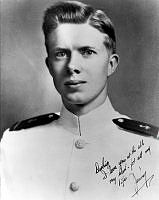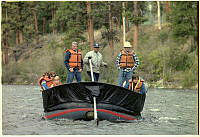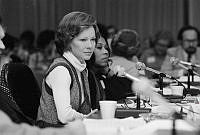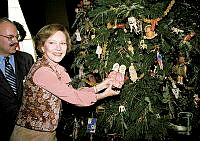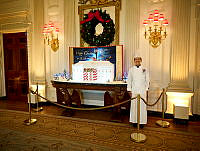Julia Tyler

Julia Gardiner was born to David and Juliana Gardiner in 1820 on Gardiner’s Island, New York.1 As the daughter of one of New York’s wealthiest and most prominent families, Julia received a private school education at Madame N.D. Chagaray Institute for Young Ladies and toured Europe with her family.2
Upon returning to the United States, Julia met President John Tyler at a White House event. After the death of his wife Letitia in 1842, he went on to court Miss Gardiner—though she was thirty years his junior.3 Julia turned down several of his advances, but a tragedy brought them together. On February 28, 1844, they both embarked on a Potomac River cruise aboard the USS Princeton, a new naval warship. One of the guns on board exploded that day, killing six individuals, including cabinet secretaries, an enslaved servant, and Julia’s father David.4 After the explosion, she accepted the president’s proposal and the two married on June 26, 1844, in New York. A White House reception followed.5
Julia replaced the president’s daughter-in-law, Priscilla Cooper Tyler, and daughter, Letitia Semple, who had filled in as White House hostess after the death of Letitia Tyler.6 Though she was only first lady for the final eight months of John Tyler’s presidency, she brought youth and vitality back to a White House in mourning. Julia hosted formal dinners and introduced the waltz at her lively balls and parties.7 Historians also argue that she assisted in lobbying for the annexation of Texas—one of Tyler’s major achievements as president.8
After leaving the White House in 1845, the Tylers moved to Sherwood Forest, a plantation in Charles City County, Virginia.9 Together, John and Julia had seven children: David (1846), John (1848), Julia (1849), Lachlan (1851), Lyon (1853), Robert (1856), and Pearl (1860).10 Despite her New York upbringing, Julia embraced the persona of a Southern belle, hosting grand parties made possible by the many enslaved people living and working at Sherwood Forest.11 She took to defending the institution of slavery, even publishing an open letter on the subject in the Richmond Enquirer. She also supported her husband's election to the Confederate House of Representatives, but he died in 1862 before it assembled.12
John Tyler did not live to see the end of the Civil War, but Julia did. Because of her sympathies for the Confederacy, she became a polarizing public figure. This complicated her efforts to receive a federal pension as a widowed presidential spouse, though she was ultimately successful.13
Julia Tyler continued to visit the White House, calling on presidents and first ladies and attending events held there. She was also the impetus for the Executive Mansion’s collection of first lady portraits, proposing the idea and donating her own portrait during Andrew Johnson’s presidency.14
Julia spent the final years of her life in Richmond, Virginia, and died there on July 10, 1889. She is buried at Hollywood Cemetery alongside her husband.15
Footnotes & Resources
- There are several discrepancies regarding Julia Tyler’s exact birth date; only the year is definite.
- “Julia Tyler,” National First Ladies Library, https://firstladies.org/home/first-ladies/julia-tyler.
- A Companion to First Ladies, Ed. Katherine A. S. Sibley (Hoboken, NJ: Wiley Blackwell, 2016), Ebook.
- Ann Blackman, “Fatal Cruise of the Princeton,” U.S. Naval Institute, https://www.usni.org/magazines/naval-history-magazine/2005/october/fatal-cruise-princeton.
- “How Many Weddings Have Been Held at the White House,” White House Historical Association, https://www.whitehousehistory.org/questions/how-many-weddings-have-been-held-at-the-white-house.
- Rosie Cain, “White House Hostesses: Forgotten First Ladies,” White House Historical Association, https://www.whitehousehistory.org/white-house-hostesses-the-forgotten-first-ladies.
- William Seale, The President’s House Vol. 1 (Washington, D.C.: White House Historical Association, 1986), 241-242.
- Christopher J. Leahy and Sharon Williams Leahy, “Reclamation of a First Lady: Julia Gardiner Tyler’s Pursuit of a Federal Government Pension,” in Southern First Ladies: Culture and Place in White House History Ed. Katherine A. S. Sibley (Lawrence, KS: University Press of Kansas, 2020), 75.
- Matthew Costello, “The Enslaved Households of President John Tyler,” White House Historical Association, https://www.whitehousehistory.org/the-enslaved-households-of-president-john-tyler.
- “Genealogy of John Tyler and His Descendants,” Sherwood Forest, http://www.sherwoodforest.org/Genealogy.html.
- Matthew Costello, “The Enslaved Households of President John Tyler,” White House Historical Association, https://www.whitehousehistory.org/the-enslaved-households-of-president-john-tyler; Leahy and Leahy, “Reclamation of a First Lady: Julia Gardiner Tyler’s Pursuit of a Federal Government Pension,” in Southern First Ladies: Culture and Place in White House History.
- Ibid.
- Ibid.
- William Kloss, Art in the White House: A Nation’s Pride (Washington, D.C.: White House Historical Association, 2008), 31.
- “Julia Tyler,” National First Ladies Library, https://firstladies.org/home/first-ladies/julia-tyler.















